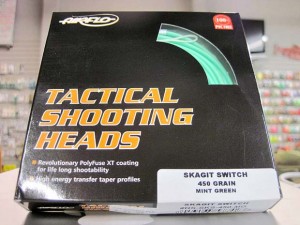By Fly Fisherman Magazine
There has been a rapid evolution of lines for two-handed rods in the last ten years. Historically, Spey lines were designed with a long belly and a taper that was similar to a double-taper line. This style of line was mainly used to fish a fly on or near the surface, and to be cast using a long two-handed rod with slow, methodical casting movements.
Today, lines are manufactured for more specific fishing situations
Head lengths are generally shorter and designed in a manner similar to a weight-forward taper.
Airflo
Skagit Compact – 540 grain $55 The Skagit compact varies in head length from 22.5-feet to 27-feet depending on the grain weight. I used the 540-grain, which is 25 feet. All Airflo lines have a marking printed into the tip loop denoting the type of line and grain weight. This makes it easy to keep multiple lines and heads organized. Airflo heads are packed in a Ziploc sleeve with two reinforced holes that can be placed in a two-ring binder for storage. The Airflo compact Skagit is an impressive and versatile line. While it casts smoothly with tight loops when using lighter tips, the head is also capable of maintaining tight casting loops with a heavy 15-foot length of T-17 and a weighted fly. Airflo also has a Skagit line with an intermediate front taper to assist in avoiding the effects of uneven surface currents, and for attaining even greater depth.
Rage Compact – 540 grain $55 The Rage varies in head length from 28-feet to 32-feet depending on grain weight. The objective of the Rage Compact is to create a Skagit line for floating line/surface situations. I would consider this more of a hybrid line between Skagit and Scandi. The Rage has an aggressive front taper creating significant power on the forward casting stroke. I found the Rage capable of precision, and tight loops. It can handle a floating leader or tapered sinking-tips, making it a good choice when depth isn’t the key consideration.
Skagit Switch – 450 grain $55 With the increasing popularity of switch rods, it is natural that lines designed specifically for them are being offered by many manufacturers. The Skagit Switch has the characteristics of a full Skagit condensed into a head ranging from 18.5-feet to 20-feet. This line allows a switch rod to cast with power and distance in confined areas. I found that slower rod movements in the setup and forward stroke allowed this line to fully load the rod, and create a smooth delivery with either light or heavy 12-foot tips.
Delta Spey Multi-Tips – 8/9 $150 The Delta Spey has a midsize head that delivers casts with power and control. Its head length ranges from 52-feet to 56-feet and it has a smooth front taper that is capable of precision tight loops even with heavy Type 8 tips. The length of this head reduces the amount of line stripping you’ll do when compared to shorter head lines, making it ideal for covering big waters—especially in the winter. The Delta Spey has an integrated running line with a built-in marker to indicate the best point to load up the cast. To contact Rajeff Sports click here […]
To read complete story click here […]



